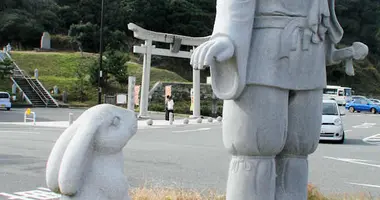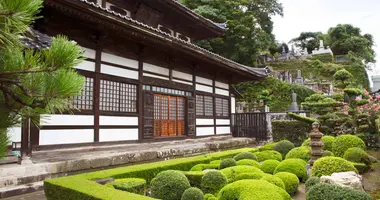Ube Shrine Tottori
- Published on : 20/02/2018
- by : Japan Experience
- Youtube
Ube Shrine is very popular shrine in Tottori having been the Ichinomiya, the highest ranked shrine in the province in historical times. Ube Shrine is famous for many benefits including longevity, the protection of children, and the attainment of prosperity.
Ube Shrine, Tottori 宇倍神社
Jake Davies
Though located a little out of the central downtown area of Tottori city, Ube Shrine is very popular having been the Ichinomiya, the highest ranked shrine in the province in historical times. Ube Shrine is famous for many benefits including longevity, the protection of children, and the attainment of prosperity.
 The main building of Ube Shrine, once portrayed on the 5 yen banknote
The main building of Ube Shrine, once portrayed on the 5 yen banknote A pair of stones in the grounds of Ube Shrine. Takenouchi left his sandals here when he ascended to become a kami
A pair of stones in the grounds of Ube Shrine. Takenouchi left his sandals here when he ascended to become a kami
History
According to the shrine's founding legend it was established in 648, though the current shrine buildings only date back to 1898. They used to be quite famous as their image was on the 5 yen banknote in the early twentieth century, alongside the kami enshrined here, the mythical/legendary figure Takenouchi no Sukune, who also appeared on the 1 yen note. This no doubt helped connect the shrine with prayers for prosperity.

A very popular shrine for the protection of children, especially around the time of the Shichi Go San festival in November, but also around Boy's Day, May 5th. Entrance to Ube Shrine, Tottori City
Entrance to Ube Shrine, Tottori City
Takenouchi was supposedly born of royal blood in prehistoric times and served as a minister to five different emperors from Keiko to Nintoku. This remarkable feat was made possible because he is claimed to have lived to almost 300 years of age. His remarkable longevity is attributed to the waters of a sacred well which today still feeds into the purification basin, temizuya, of Ube Shrine.
He is most well known however for the part he played in the myth/legend of Jingu. Sometimes referred to as Empress, sometimes as Regent, Jingu was a consort of Emperor Chuai, and following his death she led an invasion of Korea, though there seems to be no historical evidence for such an invasion.
Takenouchi's role is variously described as shaman, general, or Prime Minister. Jingu was carrying a child of Chuai in her womb for the three years of the campaign and following her return to Japan gave birth to the child who became Emperor Ojin, nowadays commonly known as the kami Hachiman. Takenouchi acted as mentor to Ojin, and this is the source of his connection to the protection of children.
Many of the ancient powerful clans that made up the imperial court in ancient times claim descent from Takenouchi, including the Soga and the Katsuragi.
Ube Shrine is popular all year round, but especially around Children's Day, May 5th, Shichi Go San in mid-November, when the autumn colors are also on display, and for the Miyuki Matsuri on the 20th and 21st April, when a unique dance performance takes place. The shrine is unusual in that is has some omikuji, fortune slips, available in English.
 Small bridge over a koi pond at Ube Shrine, Tottori City
Small bridge over a koi pond at Ube Shrine, Tottori City
Access
Ube Shrine
651 Miyashita, Kokufu-cho
Tottori-shi, Tottori 680-0151
Tel: 0857 22 5025
Take the Nakagawara Line bus from Tottori Station and get off at Miyanoshita Jingu-mae.
Nearby
The family graves of the Ikeda family, the ruling feudal lords (daimyo) of Tottori are located nearby.













